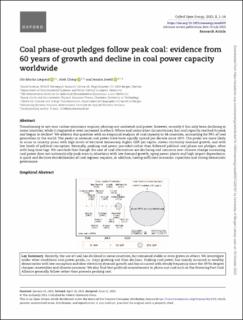Coal phase-out pledges follow peak coal: evidence from 60 years of growth and decline in coal power capacity worldwide
| dc.contributor.author | Lægreid, Ole Martin | |
| dc.contributor.author | Cherp, Aleh | |
| dc.contributor.author | Jewell, Jessica | |
| dc.date.accessioned | 2023-12-21T12:34:58Z | |
| dc.date.available | 2023-12-21T12:34:58Z | |
| dc.date.created | 2023-10-12T13:43:16Z | |
| dc.date.issued | 2023 | |
| dc.identifier.issn | 2752-5082 | |
| dc.identifier.uri | https://hdl.handle.net/11250/3108589 | |
| dc.description.abstract | Transitioning to net-zero carbon emissions requires phasing-out unabated coal power; however, recently it has only been declining in some countries, while it stagnated or even increased in others. Where and under what circumstances, has coal capacity reached its peak and begun to decline? We address this question with an empirical analysis of coal capacity in 56 countries, accounting for 99% of coal generation in the world. The peaks in national coal power have been equally spread per decade since 1970. The peaks are more likely to occur in country-years with high levels of electoral democracy, higher GDP per capita, slower electricity demand growth, and with low levels of political corruption. Normally, peaking coal power preceded rather than followed political coal phase-out pledges, often with long time lags. We conclude that though the cost of coal alternatives are declining and concerns over climate change increasing, coal power does not automatically peak even in situations with low demand growth, aging power plants and high import dependence. A quick and decisive destabilization of coal regimes requires, in addition, having sufficient economic capacities and strong democratic governance. | en_US |
| dc.language.iso | eng | en_US |
| dc.rights | Navngivelse 4.0 Internasjonal | * |
| dc.rights.uri | http://creativecommons.org/licenses/by/4.0/deed.no | * |
| dc.title | Coal phase-out pledges follow peak coal: evidence from 60 years of growth and decline in coal power capacity worldwide | en_US |
| dc.type | Journal article | en_US |
| dc.type | Peer reviewed | en_US |
| dc.description.version | publishedVersion | en_US |
| dc.rights.holder | Copyright 2023 The Author(s) | en_US |
| dc.source.articlenumber | oiad009 | en_US |
| cristin.ispublished | true | |
| cristin.fulltext | original | |
| cristin.qualitycode | 1 | |
| dc.identifier.doi | 10.1093/ooenergy/oiad009 | |
| dc.identifier.cristin | 2184142 | |
| dc.source.journal | Oxford Open Energy | en_US |
| dc.identifier.citation | Oxford Open Energy. 2023, 2, oiad009. | en_US |
| dc.source.volume | 2 | en_US |
Tilhørende fil(er)
Denne innførselen finnes i følgende samling(er)
-
Department of Geography [634]
-
Registrations from Cristin [9673]

